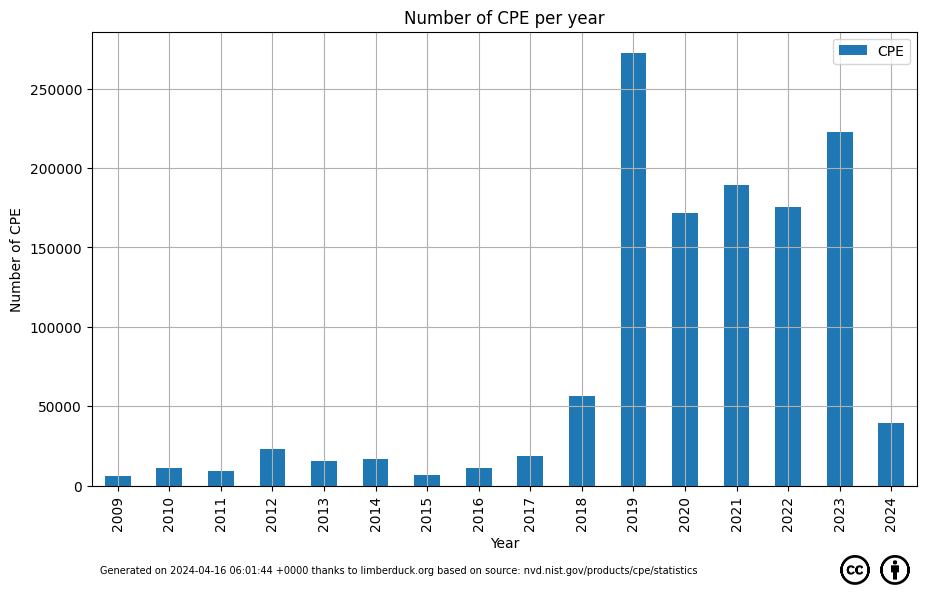CPE#
Common Platform Enumeration (CPE) is a structured naming scheme for information technology systems, software, and packages. Based upon the generic syntax for Uniform Resource Identifiers (URI), CPE includes a formal name format, a method for checking names against a system, and a description format for binding text and tests to a name. This method of naming is known as a well-formed CPE name (WFN)
source: cpe.mitre.org/specification
You can see this notebook directly via:
Generation time#
from datetime import datetime, timezone, timedelta
timezone_offset = 0.0
tzinfo = timezone(timedelta(hours=timezone_offset))
generation_time = datetime.now(tzinfo).strftime('%Y-%m-%d %H:%M:%S %z')
print(generation_time)
2024-04-16 06:01:44 +0000
Creative Commons#
This notebook and generated diagrams are released with Creative Commons liecense (CC BY 4.0).
import requests
import urllib3
urllib3.disable_warnings()
urls = ['https://mirrors.creativecommons.org/presskit/icons/cc.xlarge.png',
'https://mirrors.creativecommons.org/presskit/icons/by.xlarge.png']
for url in urls:
file_name = url.split("/")[-1:][0]
print(file_name)
file = requests.get(url, verify=False)
open(file_name, 'wb').write(file.content)
cc.xlarge.png
by.xlarge.png
CPE data downloading#
All CPE stats are taken from nvd.nist.gov/products/cpe/statistics
from urllib.request import urlopen
import ssl
from bs4 import BeautifulSoup, SoupStrainer
def get_data(url):
ctx = ssl.create_default_context()
ctx.check_hostname = False
ctx.verify_mode = ssl.CERT_NONE
page = urlopen(url, context=ctx)
html = page.read().decode("utf-8")
product = SoupStrainer('table')
soup = BeautifulSoup(html, "html.parser", parse_only=product)
return soup
url = "https://nvd.nist.gov/products/cpe/statistics"
data = get_data(url)
print(len(data))
16
New CPE entries#
CPE data parsing#
import pandas as pd
def pars(data):
data_table = []
for table in data:
table_id = table['id']
table_year = table_id[-4:]
table_rows = table.find_all("tr")
number_of_new_cpe_entries_yearly = 0
number_of_new_cpe_entries_list = []
data_row = []
for table_row in table_rows:
data = table_row.find_all("td")
if data:
number_of_new_cpe_entries = int(data[1].string.replace(",",""))
number_of_new_cpe_entries_list.append(number_of_new_cpe_entries)
number_of_new_cpe_entries_yearly += number_of_new_cpe_entries
while len(number_of_new_cpe_entries_list) < 12:
number_of_new_cpe_entries_list.append(0)
data_row.append(table_year)
data_row.append(number_of_new_cpe_entries_yearly)
data_row = data_row + number_of_new_cpe_entries_list
data_table.append(data_row)
data_columns = ['Year', 'Summary', 'January', 'February', 'March', 'April', 'May', 'June', 'July', 'August', 'September', 'October', 'November', 'December']
df = pd.DataFrame (data_table, columns = data_columns)
df.sort_values(by=['Year'], inplace=True)
df.reset_index(drop=True, inplace=True)
df.index += 1
return df
parsed_data = pars(data)
parsed_data.style.bar(subset=['Summary'], color='#FF6200')
Matplotlib is building the font cache; this may take a moment.
| Year | Summary | January | February | March | April | May | June | July | August | September | October | November | December | |
|---|---|---|---|---|---|---|---|---|---|---|---|---|---|---|
| 1 | 2009 | 5786 | 181 | 422 | 830 | 639 | 612 | 209 | 241 | 110 | 330 | 102 | 1960 | 150 |
| 2 | 2010 | 11094 | 990 | 234 | 509 | 1106 | 803 | 886 | 426 | 1252 | 707 | 1336 | 1026 | 1819 |
| 3 | 2011 | 9263 | 702 | 925 | 583 | 2252 | 818 | 682 | 430 | 390 | 423 | 470 | 737 | 851 |
| 4 | 2012 | 23235 | 1148 | 1003 | 1622 | 2501 | 3228 | 2259 | 3124 | 2887 | 1583 | 1830 | 1110 | 940 |
| 5 | 2013 | 15671 | 1460 | 1105 | 1138 | 1271 | 932 | 989 | 1623 | 1359 | 1140 | 1941 | 1327 | 1386 |
| 6 | 2014 | 16714 | 1552 | 1151 | 1644 | 2103 | 2175 | 1447 | 1606 | 886 | 885 | 260 | 1380 | 1625 |
| 7 | 2015 | 6503 | 758 | 654 | 849 | 838 | 429 | 736 | 446 | 564 | 81 | 216 | 144 | 788 |
| 8 | 2016 | 11074 | 2450 | 535 | 871 | 699 | 732 | 1471 | 321 | 762 | 979 | 452 | 696 | 1106 |
| 9 | 2017 | 18650 | 746 | 888 | 1070 | 1935 | 1494 | 1210 | 1364 | 1889 | 1516 | 1596 | 2585 | 2357 |
| 10 | 2018 | 56509 | 2273 | 2404 | 1571 | 2525 | 10489 | 5160 | 3707 | 3895 | 3722 | 10862 | 6564 | 3337 |
| 11 | 2019 | 272322 | 6810 | 7197 | 10466 | 12979 | 13181 | 32837 | 45459 | 23763 | 47195 | 26717 | 22731 | 22987 |
| 12 | 2020 | 171681 | 15960 | 18668 | 20159 | 16306 | 14157 | 11250 | 10659 | 14459 | 13077 | 10921 | 9293 | 16772 |
| 13 | 2021 | 189565 | 11253 | 14969 | 18562 | 15476 | 13997 | 18730 | 20791 | 16531 | 14022 | 16164 | 17160 | 11910 |
| 14 | 2022 | 175793 | 11299 | 12125 | 13566 | 10410 | 10262 | 14432 | 13652 | 18251 | 14397 | 15560 | 14888 | 26951 |
| 15 | 2023 | 223030 | 18297 | 16483 | 22071 | 14262 | 17591 | 19858 | 18929 | 20943 | 16827 | 21344 | 18296 | 18129 |
| 16 | 2024 | 39737 | 20260 | 16220 | 2058 | 1199 | 0 | 0 | 0 | 0 | 0 | 0 | 0 | 0 |
CPE data saving#
CSV file is available in GitHub repository, see:
csv_filename = 'cpe-number-of-new-entries.csv'
parsed_data.to_csv(csv_filename, index=False)
CPE data ploting#
PNG files are available in GitHub repository with two background versions, see:
import pandas as pd
import matplotlib.pyplot as plt
import numpy as np
import urllib
df = pd.read_csv(csv_filename)
df.plot(x='Year',
xlabel='Year',
y='Summary',
ylabel='Number of CPE',
kind='bar',
title='Number of CPE per year')
plt.tight_layout()
plt.legend(['CPE'])
plt.figtext(0.16, 0.02, f"Generated on {generation_time} thanks to limberduck.org based on source: nvd.nist.gov/products/cpe/statistics", ha="left", fontsize=7)
fig = plt.gcf()
fig.set_size_inches(10,6)
fig.patch.set_facecolor('white')
plt.grid(True)
img_cc = plt.imread('cc.xlarge.png')
newax_cc = fig.add_axes([0.88, 0.0, 0.05, 0.05], anchor='NE', zorder=-1)
newax_cc.imshow(img_cc)
newax_cc.axis('off')
img_by = plt.imread('by.xlarge.png')
newax_by = fig.add_axes([0.92, 0.0, 0.05, 0.05], anchor='NE', zorder=-1)
newax_by.imshow(img_by)
newax_by.axis('off')
plt.savefig('cpe-number-of-new-entries-bg-white.png', dpi = 300, facecolor = 'white')
plt.savefig('cpe-number-of-new-entries-bg-transparent.png', dpi = 300, transparent = True)

